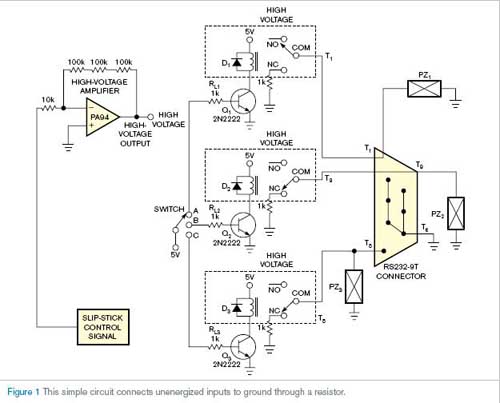一個(gè)簡(jiǎn)單的繼電器電路消除掃描式電子顯微鏡的雙級(jí)制動(dòng)器中噪聲。
大多數(shù)實(shí)驗(yàn)室和工業(yè)環(huán)境中存在全頻率下有多種電子噪聲源,主要來(lái)自重型設(shè)備、器械、能量源和顯示器。工程師使用過許多簡(jiǎn)單設(shè)備和技術(shù)來(lái)處理這種噪聲,包括使用適當(dāng)接地方法、屏蔽和絞電纜、信號(hào)平均、差分輸入電壓放大器和濾波器。
雖然這些方法在大多數(shù)測(cè)量中能控制和減少噪聲,但是一些技術(shù)只是防止噪聲進(jìn)入系統(tǒng),而其他只是去除信號(hào)中的外來(lái)噪聲。這些方法通常只在低壓系統(tǒng)中使用;不能用于高壓系統(tǒng)引起的噪聲。
本設(shè)計(jì)方案提供了一種減少高壓引起噪聲的實(shí)用方法。掃描式電子顯微鏡的浮動(dòng)輸入為高阻抗,就像是天線一樣獲取
噪聲信號(hào)。顯微鏡的激勵(lì)需要高壓信號(hào)來(lái)驅(qū)動(dòng)它們的壓電滑粘防噴器電動(dòng)機(jī)。運(yùn)動(dòng)機(jī)構(gòu)需要范圍為800V峰峰值的斜坡波形。因?yàn)榧舛诉\(yùn)動(dòng)有三種程度,所以機(jī)構(gòu)也要多個(gè)通道。一些顯微鏡將原子力顯微鏡與光程調(diào)整的顯微鏡載片合并,這就需要更多通道。
傳統(tǒng)上,每通道需要一個(gè)高壓放大器。所以兩維的尖端運(yùn)動(dòng)需要兩個(gè)高壓放大器,三維的需要三個(gè)高壓放大器,以此類推。高壓放大器價(jià)格昂貴,且需要PCB板上相當(dāng)大的空間。因此,只使用一個(gè)轉(zhuǎn)換多通道間的高壓放大器控制多維尖端運(yùn)動(dòng),可以節(jié)省價(jià)錢和空間。高壓連接器管腳間有足夠空間,避免干擾鄰近信號(hào)。但是高壓連接器昂貴,且體積過大難以排列。所以最好的選擇是使用商業(yè)RS-232標(biāo)準(zhǔn)的9/25管腳連接器(圖1)。大多數(shù)商業(yè)RS-232連接器的管腳很接近,容易接收到高壓引起的噪聲。通過連接一個(gè)低阻抗到RS-232連接器的浮動(dòng)引腳,可以解決這個(gè)問題。

這個(gè)電路中,三個(gè)壓電發(fā)動(dòng)機(jī)PZ1、PZ2和PZ3,連接到RS 232 9T連接器的T1、T5和T9管腳。電路有三個(gè)繼電器轉(zhuǎn)換壓電發(fā)動(dòng)機(jī)的高壓輸入。通常繼電器開環(huán)節(jié)點(diǎn)連接到高壓放大器輸出;繼電器閉環(huán)節(jié)點(diǎn)連接到三個(gè)1 kΩ電阻,將高壓引起的噪聲旁路到地。
英文原文:
Relays eliminate high-voltage noise
A simple relay circuit cancels noise in the actuator stage of a scanning electron microscope.
Jui-I Tsai, Woei-Wu Pai, Feng-Chang Hsu, Po-Jui Chen, Ching-Cheng Teng, and Tai-Shan Liao, National Applied Research Laboratories, Hsinchu, Taiwan; Edited By Charles H Small and Fran Granville -- EDN, 9/13/2007
Most laboratories and industrial environments have many kinds of electrical-noise sources at all frequencies from heavy machinery, instruments, power supplies, and TV stations. Engineers have used many simple devices and techniques to handle this noise. These techniques include the use of proper grounding methods, shielded and twisted wires, signal averaging, differential-input-voltage amplifiers, and filters.
Although these methods can control and reduce the noise in most measurements, some techniques just prevent noise from entering the system, whereas others remove only extraneous noise from the signal. These methods usually find use only in low-voltage systems; they do not address high-voltage-induced noise.
This Design Idea offers a practical approach to reducing high-voltage-induced noise. The floating input of a scanning electron microscope has high impedance, and it acts as an antenna, picking up noise signals. The microscope’s actuators need a high-voltage signal to drive their piezoelectric slip-stick stack motors. The motion mechanism requires a ramping waveform spanning to 800V p-p. The mechanism requires multiple channels because there are three degrees of tip motion. Some microscopes incorporate optical-path-adjustment microsliders for atomic-force microscopy; those scopes need even more channel
s.
Traditionally, each channel needs a high-voltage amplifier. So, two degrees of tip motion need two high-voltage amplifiers, three degrees need three amplifiers, and so on. High-voltage amplifiers are expensive and need considerable space on the PCB (printed-circuit board), however. Therefore, controlling multiple degrees of tip motion using only one high-voltage amplifier that switches among multiple channels saves cost and space. The pins of high-voltage connectors have enough space between them to avoid disturbing adjacent signals. But high-voltage connectors are expensive and too large to easily arrange. So, the best choice is to use a commercial RS?232-standard, nine-pin/25-pin connector (Figure 1). The pins of most commercial RS?232 connectors are close enough together to easily pick up induced high-voltage signals. You can solve this problem by connecting a low impedance to the floating pins of the RS?232 connector.
In this circuit, three piezoelectric motors, PZ1, PZ2, and PZ3, connect to the T1, T5, and T9 pins of the RS?232?9T connector. The circuit has three relays that switch the high-voltage input to the piezoelectric motors. The normally open node of the relays connects to the high-voltage-amplifier output. The normally closed nodes of the relays connect to three 1?kΩ resistors to bypass high-voltage-induced noise to ground.

